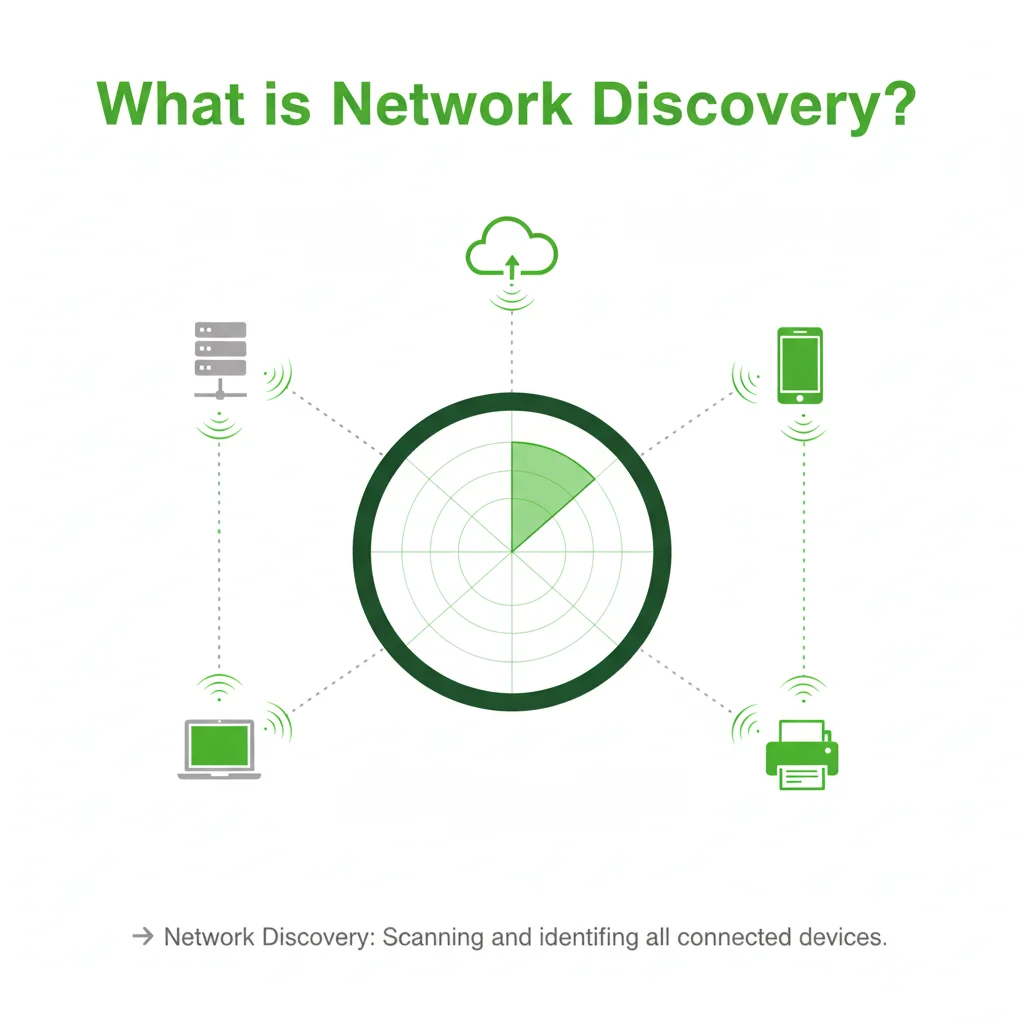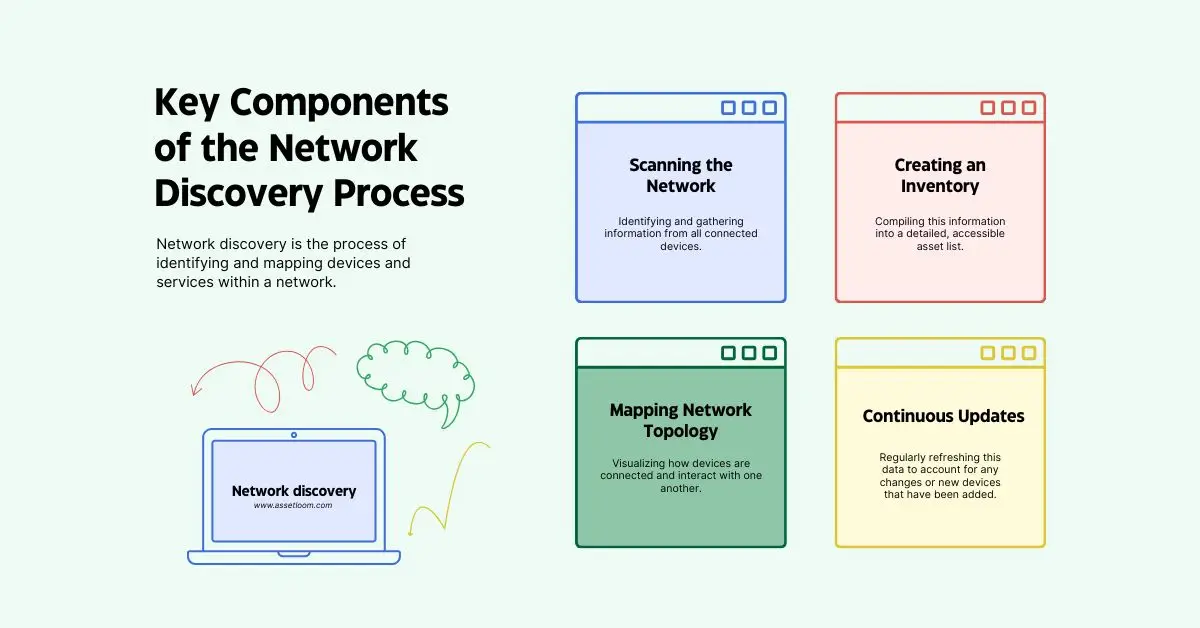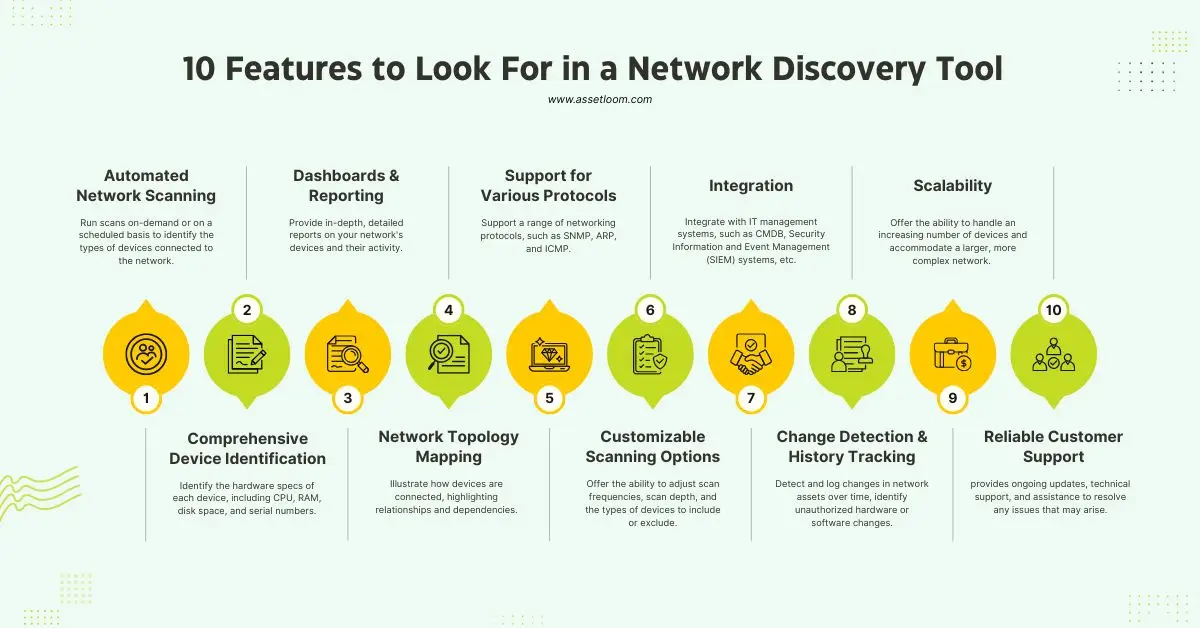Understanding Network Discovery Scan: Top Features to Look For
A network discovery scan is vital in this day and age to ensure every device is accounted for. Explore key features and how they work.
Strong network visibility and management are essential, as evidenced by Opengea research showing that 91% of multinational corporations experience at least one network outage every three months.
A network discovery scan is one crucial step that helps companies find and map every device and service connected to their network. Regular scans allow businesses to maintain an accurate inventory of their IT assets, which is essential for effective network management, security, and compliance.
This article explains the key components to consider when evaluating a network discovery tool, as well as the components and operation of a network discovery scan.
What is Network Discovery?
The process of finding and mapping devices and services within a network is the fundamental function of a network discovery scan. In addition to PCs and servers, this also includes routers, switches, printers, and even more specialized equipment like Internet of Things (IoT) components. By collecting data about these linked devices, a network discovery scan enables network managers to create a current inventory of all network resources.

Keeping up-to-date and accurate knowledge of every device in your IT infrastructure is the aim of a network discovery scan. In addition to being essential for daily network management, this visibility is also necessary for enhancing security, maximizing network performance, and guaranteeing adherence to industry rules.
Key components in the network discovery scan process include:
Scanning the Network
The first step in a network discovery scan is identifying every device that connects to your network. This includes familiar equipment like laptops, desktops, and servers, as well as mobile devices, printers, and even IoT gadgets that often go unnoticed. During the scan, the tool collects key details such as IP addresses, hostnames, operating systems, and active services. Having this full picture makes it easier for IT teams to understand what resources are in use, spot any unauthorized devices, and make sure nothing important slips through the cracks.
Creating an Inventory
After devices are scanned and identified, the next step is pulling that information into a structured inventory. This inventory acts as a detailed list of all your assets—covering hardware like laptops and servers, software installations, mobile devices, and even network components. By having everything in one place, IT teams can quickly check what’s in use, who it’s assigned to, and where it’s located. A well-maintained inventory also supports tasks like audits, compliance checks, and planning for upgrades or replacements.
Mapping Network Topology
Once the devices are discovered and added to an inventory, the next step is understanding how they connect with each other. A network topology map shows these relationships in a visual way—like a diagram of all the pathways between servers, workstations, routers, switches, and other devices. This makes it easier to see dependencies, identify potential bottlenecks, and detect unusual or unauthorized connections. For IT teams, a clear map is especially helpful when troubleshooting outages, planning network expansions, or making sure critical systems stay connected.
Continuous Updates
A network is never static—new laptops get added, old servers are retired, and software versions change all the time. That’s why continuous updates are a key part of the discovery process. Instead of relying on a one-time scan that quickly becomes outdated, the system regularly refreshes the data to reflect the current state of the network. This ensures your inventory stays accurate, makes audits easier, and helps IT teams respond quickly if an unknown or suspicious device appears.

To maintain the accuracy of your inventory, a network discovery scan is a continuous procedure that calls for regular scans. Without this kind of visibility, businesses might find it difficult to properly manage their IT resources, which could result in performance problems, security flaws, or even network outages.
How Does Network Discovery Work?
A network discovery scan starts by looking for and classifying devices on the network. Various scanning techniques are applied based on the particular network configuration, devices, and objectives.
The following are a few of the most popular methods for network discovery scans:
- Ping Scanning: To find out which IP addresses are active, this technique sends ICMP (ping) requests to a variety of IP addresses within the network. Ping-responsive devices are regarded as online and accessible for additional verification.
- Port Scanning: This method looks through network devices' available ports. The existence of particular services or applications operating on a device is frequently indicated by open ports. Finding out what services a device is providing can be aided by port scanning.
- Protocol-Specific Methods: A network discovery scan collects data about connected devices using a variety of protocols.
For instance:
- SNMP (Simple Network Management Protocol): Used for monitoring and managing network devices like routers and switches, SNMP provides valuable insights into device configurations and status.
- ARP (Address Resolution Protocol): ARP maps IP addresses to physical (MAC) addresses, helping to identify which devices correspond to specific IPs.
Network discovery scans usually combine active and passive scanning techniques in addition to these. While passive scans keep an eye on network traffic to collect information about devices without speaking to them directly, active scans actively probe devices for information.
What to Look for in a Network Discovery Tool
A number of factors should be taken into account when assessing a network discovery tool to make sure it meets the needs of your company. Below is a summary of the key attributes and functionalities:

1. Automated Network Scanning
A top-tier network discovery tool should be able to automatically scan IP ranges and subnets to detect live devices across your network. Automated network scanning tools should be able to process identifying device types connected to the network, such as PCs, servers, routers, printers, and more. Additionally, it should provide the option to perform scans on-demand or on a prearranged schedule, enabling continuous and real-time monitoring without the need for manual intervention.
2. Comprehensive Device Identification
A useful network discovery tool doesn’t just tell you that a device exists—it shows you what’s inside it. This means capturing hardware details like CPU power, memory (RAM), disk space, and even serial numbers. On the software side, it should note the operating system, update levels, and important configuration settings.
For example, imagine you’re checking a company laptop. The scan might show:
- CPU: Intel i7
- RAM: 16 GB
- Disk Space: 512 GB SSD
- Operating System: Windows 11 Pro, with the latest security patch
- Serial Number: LPT-2025-1234
Having this information in one place helps IT teams keep an eye on performance, spot devices that are outdated, and make sure all systems meet security and compliance requirements. It also makes troubleshooting much faster—for instance, knowing if a slow computer is due to limited RAM or an old operating system.
3. Detailed Reporting Features
In-depth, comprehensive reports on the devices and their activities on your network should be provided by a network discovery tool. Both preset and customizable options ought to be available in these reports so you can extract the precise data you require. Making informed decisions requires thorough reporting, whether you're tracking configurations, network traffic, or device performance.
4. Network Topology Mapping
Another important part of network discovery is being able to see how everything is connected. A topology map is like a diagram of your network—it shows which devices talk to each other and how data flows between them.
For example, the map might show that all employee laptops connect to a central switch, which then links to the main server and firewall. If the switch is overloaded, you’ll quickly see it as a bottleneck in the diagram.
This visual layout helps administrators understand their network’s structure, spot weak points, and plan improvements. Many discovery tools make this process easier by automatically creating a clear, visual map that updates as devices are added or removed.
5. Support for Various Protocols
For a discovery tool to work properly, it has to “speak the same language” as the devices on your network. This is where protocols come in. Common ones include SNMP (used to pull details like device health), ARP (used to link IP addresses with hardware), and ICMP (used for simple checks like ping).
Depending on your setup, you might also need support for other, more specialized protocols. For example, if you manage a network of Linux servers, the tool should support SSH so it can securely gather system details. In a Windows-heavy environment, WMI support might be essential.
The key is to make sure the tool fits your network’s unique requirements and works smoothly with the devices you already have.
6. Customizable Scanning Options
Not every network looks the same, so your discovery tool should let you adjust how scans are run. This includes choosing how often scans happen, how deep they go, and which devices to include or leave out.
For example, a hospital might want frequent scans of medical devices to make sure they’re always online, but only schedule weekly scans of office printers. A large company might choose deep scans for servers to collect detailed hardware and software data, while running lighter scans on employee laptops to reduce network load.
Having this flexibility means the tool can adapt to your organization’s setup, instead of forcing you into a one-size-fits-all approach.
7. Integration with Existing IT Systems
A network discovery tool is most effective when integrated with your organization’s existing IT management systems, such as Configuration Management Databases (CMDB), Security Information and Event Management (SIEM) systems, or other network monitoring tools. Seamless integration allows for more efficient data sharing and enhances overall IT management.
8. Change Detection & History Tracking
The ability to identify and record changes in network assets over time is a must for any good network discovery tool. This is crucial for spotting unapproved software or hardware modifications, which aids businesses in keeping network control. Because it offers a history of network assets and their changes, change detection is also very helpful in audits and incident response.
9. Scalability
A network discovery tool needs to be scalable in order to keep up with network growth. This entails managing a growing number of devices and making room for a more expansive and intricate network. For businesses that are expanding quickly or have dynamic networks that undergo frequent changes, scalability is essential.
10. Reliable Customer Support
Finally, when utilizing any network discovery tool, a trustworthy customer service team is a priceless asset. Make sure the vendor offers regular updates, technical support, and help to fix any problems that may come up.
Conclusion
One essential tool for keeping an eye on your network infrastructure is a network discovery scan. Network discovery scans map and identify every connected device, giving vital information for asset management, performance optimization, and security. Look for features like real-time scanning, thorough device identification, thorough reporting, and network topology mapping when assessing network discovery scan tools. Other crucial factors to make sure the tool can expand with your company are scalability, customization, and integration with current systems. Your IT staff can stay ahead of possible issues and maintain the functionality of your network by putting in place a network discovery scan solution, which can simplify network management, speed up troubleshooting, and enhance overall security.
Frequently Asked Questions (FAQ)
1. What is a network discovery scan? A network discovery scan is a process that automatically finds all the devices connected to your network, such as laptops, servers, printers, and IoT devices, and collects details about them.
2. Why is network discovery important? It gives IT teams a clear picture of what’s on the network. This helps with security, troubleshooting, planning upgrades, and making sure devices follow compliance rules.
3. How often should I run a network discovery scan? That depends on your setup. Some organizations scan daily or weekly, while others keep scans running continuously so the inventory is always current.
4. What kind of devices can a discovery tool detect? Most tools can identify desktops, laptops, servers, mobile devices, printers, switches, routers, and even IoT equipment. Advanced tools can also detect virtual machines and cloud services.
5. Do I need technical skills to use a network discovery tool? Many modern tools are designed to be user-friendly. While some technical knowledge helps, most tools include dashboards and visual maps that make the results easier to understand.
6. Is network discovery secure? Yes, when done with trusted tools. They use secure protocols and credential management to collect data safely. Unauthorized or unknown devices detected by the scan can actually help improve security by flagging risks.
7. How does network discovery support compliance? By keeping an accurate, up-to-date inventory, discovery tools help prove that devices are patched, properly configured, and accounted for during audits.

Subscribe for Expert Tips and Updates
Receive the latest news from AssetLoom, right in your inbox.


